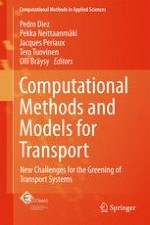2018 | OriginalPaper | Chapter
14. Investigating Side-Wind Stability of High Speed Trains Using High Resolution Large Eddy Simulations and Hybrid Models
Authors : Moritz M. Fragner, Ralf Deiterding
Published in: Computational Methods and Models for Transport
Publisher: Springer International Publishing
Activate our intelligent search to find suitable subject content or patents.
Select sections of text to find matching patents with Artificial Intelligence. powered by
Select sections of text to find additional relevant content using AI-assisted search. powered by
